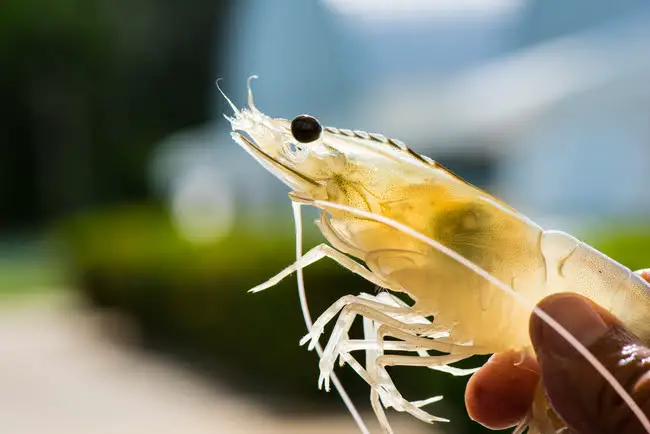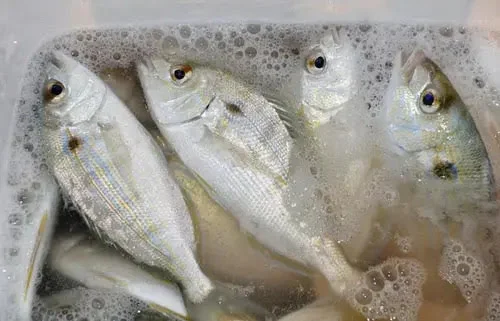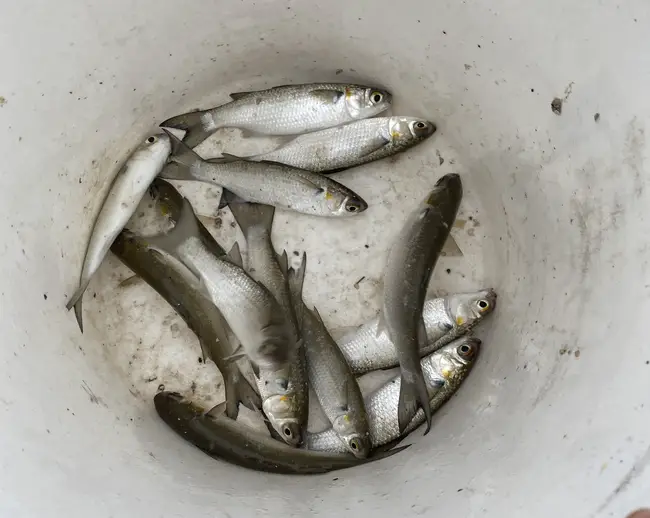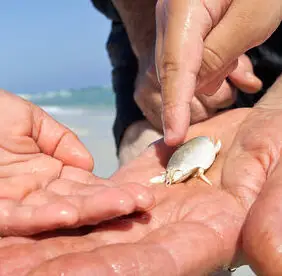Getting started with saltwater fishing is pretty forgiving and doesn’t require much prep work. Since most fish are scavengers in addition to predators, they’ll eat fresh or frozen cut bait if the opportunity presents itself.
But for anglers looking to really up their game, live bait is the way to do it.
Fishing with live baits can increase your bite and hookup rates dramatically, and may make the difference between a skunk and a trophy fish on some days!
This list is not presented in any specific order, as there is no single “best” bait. Each and every option is good for different fish under different circumstances, and many overlap with each other in some areas.
So let’s sharpen our brains and get hooked on some knowledge about the 7 best live baits for saltwater fishing!
Table of Contents
- The Jack of All Trades: Live Shrimp
- The Soft Shell Life: Peeler Crabs
- Mind the Spikes: Live Pinfish
- A Forager’s Dream: Live Mussels
- Seasonal Madness: Striped Mullet
- Surf Champions: Mole Crabs or Sand Fleas
- Food of the Underworld: Live Squid
- Conclusion
The Jack of All Trades: Live Shrimp
If it’s your first time fishing with live bait, I would recommend nothing else more than live shrimp.
Easily purchased from any bait shop, they are one of the most accessible live baits out there as well as some of the easiest to keep alive.
Big stores like Walmart often carry small and cheap aerated bait buckets that work more than well enough!
The best thing about live shrimp is that it can be fished in many different ways for many different species. Because of their prevalence in almost all marine waters, practically every fish will take the opportunity to wolf down a live shrimp!

With a bit of practice, you can even catch your own live shrimp…and whatever you don’t use for bait, you can eat for dinner!
Weighted bottom fishing, bobber drifting, or casting a baited hook with nothing else can all net you different species of marine fish.
My personal favorite use for this bait is to fish under bridges with a live shrimp hooked through the back on a chartreuse jig head.
Simply casting and reeling in slowly has caught me fish such as sheepshead, snook, grouper, spanish mackerel, and more.
The Soft Shell Life: Peeler Crabs
Crabs are a common food source for many bottom feeding fish like flounder and black drum, but their hard shells mean that they’re usually a little tough to hook.
But fret not; bait stores will often sell ‘softshell’ or ‘peeler’ crabs for this exact reason! These are small crabs that have just finished molting and lack any kind of hard shell making them easier to hook.
Keeping them alive before hooking them is pretty easy; they’re crustaceans like shrimp and are just as tolerant of warm or low-oxygen water.
Getting them on the hook can be as simple as piercing them straight through the back, but there are more advanced methods of declawing and cutting the crabs that can be readily found online.
These can help in certain situations but aren’t generally necessary!
Crabs naturally live on the bottom, so this is where they’re best fished. Rigs like the fishfinder can even allow the crab to move around a little bit on the bottom. This natural appearance is sure to entice a hungry bottom feeder to bite.
Mind the Spikes: Live Pinfish
The U.S. Southeast is absolutely crawling with these tiny sheepshead relatives, and their small size makes them the ideal prey for tons of predatory gamefish.
Tarpon, snapper, snook, and many other large game fish will hit this bait like a freight train, so be ready for a fight if you use them!
Bait shops may sell pinfish, but a cast net in shallow water also has a good chance of nabbing some.
I prefer the latter method since you can keep the fish in a container with holes right in the water; transporting them alive and well requires some heavier-duty aerated containers.
Pinfish can be hooked through the mouth or back, and a common practice is to cut off their sharp dorsal spines with a bait knife first (these give them their ‘pin’ name!).

Fish live pinfish with little to no weight (freeline) so that they can swim around and attract a hungry fish with their motion.
Sandy flats offer the lowest risk the pinfish getting you snagged, but docks, vegetation, seawalls and other structure are also good places to search.
A Forager’s Dream: Live Mussels
Mussels can be readily found clinging to rocks, pilings, and other hard surfaces that rise out of the water during low tide.
If you can get to them, they’re free! Even if you weren’t planning to fish with live bait, you may decide to go for it on a whim if you happen to see a colony of nice-sized mussels.
This bait is ideal for foraging but can be challenging to get on the hook. A dull knife is needed to pry open their shells, and their meat is delicate and falls off the hook rather easily.
Two common solutions are letting the mussels dry in the sun or tying them to the hook with thread loops.
Though the mussel is technically dead by the time you fish it, the freshness helps to attract more fish. They’re great for bottom fishing just like peeler crabs, but are smaller, allowing more fish to fit them in their mouths!
Seasonal Madness: Striped Mullet
While this fish can be used year-round, it will offer the best action during the fall mullet run!
This bait fish forms massive schools as they run down the Atlantic coast to spawn between August and November each year, and predatory fish are especially hungry for them during this time.

Running mullet can often be seen from the beach, and a well-placed cast net throw can often net you several.
A sabiki rig on lighter tackle can also work well if you’re in the mood to do some ‘appetizer’ mullet fishing before the main course! They will need a larger bait bucket or live well similar to pinfish.
Mullet can be hooked through the lips or through the back, but I prefer the lips for a more natural look.
They are very versatile during the mullet run, and can be fished freeline for topwater predators like tarpon or sunk to the bottom with a jig head or sinker for flounder, drum and other lower water predators.
During the mullet run, practically everything will eat them!
Surf Champions: Mole Crabs or Sand Fleas
Mole crabs, sand crabs, sand fleas- whatever you call them, this burrowing crustacean is another favorite of coastal foragers as they can be readily found in the surf zone.
Look for little “v” shapes in the sand after a wave recedes and use a garden trowel to scoop them out!
These little guys can be found year-round but they lay their eggs in the spring and summer, and in my experience, they’re most plentiful in early fall once many of those eggs have hatched and grown.

See Also: Can You Eat Sand Fleas? (Would You Even Want To?)
Mole crabs live almost exclusively in beach habitats, so they’re an amazing choice if you want to fish close to shore.
I’ve had success sticking anywhere from 1 to 3 crabs on the hook at a time fishfinder style with a 2 oz. sinker.
Casting just beyond where the first waves are breaking can net you a bite from flounder, striped bass, and anything else feeding close to shore!
Food of the Underworld: Live Squid
Live squid can be a bit of a tougher bait to acquire, but for offshore fishing on either coast there’s nothing better!
They can be caught on a sabiki rig or specialized squid rigs at night in deep water, and a live well has to be ready for them immediately. Thankfully, many bait shops will sell them as well, especially at coastal docks and marinas.
Squid live further from shore, so deeper water fish are naturally on the lookout for them. Many offshore charters will hook them through the head, sink them hundreds of feet down with an 8 oz. sinker, and wait for a bite.
Massive fish such as red and golden tilefish, swordfish, groupers and more can be caught with this bait… so make sure your tackle is up to the task!
Conclusion
While any live bait is almost always a step up from cut bait or lures, picking the right one for the type of fishing you’re doing can bump up your odds even more.
Each of these live baits is great for different reasons and truly shines under different conditions.
Learning why each bait works and how it does connects you to the ecosystem you’re fishing in as well as improving your chances at a bite!
This list only scratches the surface; many other live bait options exist, from the humble bloodworm to entire live eels!
There’s a bait out there for almost every specific fishing trip, but these seven are a wonderful jumping-off point for entering the world of live bait fishing. Good luck, and tight lines!
You May Also Like: Can You Use Stingray As Bait? Tips & What To Know!

Growing up in Florida, I’ve been surrounded by saltwater my entire life…and I love sharing my passion with others.
To learn more about why I started Saltwater Mecca, visit the ABOUT page.
Thank you for reading this article. Browse around & have some fun!